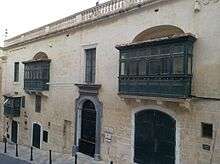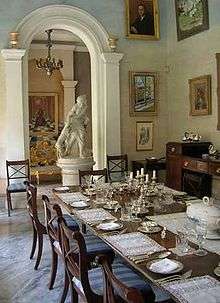Casa Rocca Piccola
 Façade of Casa Rocca Piccola | |
| Location | Valletta |
|---|---|
| Type | House |
| Website | www.casaroccapiccola.com |
Casa Rocca Piccola is a 16th-century palace in Malta, and home of the noble de Piro family. It is situated in Valletta, the capital city of Malta.[1][2] There are daily tours.[3][4] The palace includes a restaurant named as La Giara Restaurant.[5]
History
The Casa Rocca Piccola was built in 1580[6] an era in which the Knights of St John, having successfully fought off the invading Turks in 1565, decided to build a prestigious city to rival other European capitals such as Paris and Venice.[7] Palaces were designed for prestige and aesthetic beauty in most of Valletta's streets, and bastion walls fortified the new sixteenth-century city. Casa Rocca Piccola was one of two houses built in Valletta by Admiral Don Pietro la Rocca. It is referenced in maps of the time as "la casa con giardino" meaning, the house with the garden, as normally houses in Valletta were not allowed gardens.[8] Changes were made in the late 18th century to divide the house into two smaller houses. Further changes were made in 1918 and before the second world war an air raid shelters was added. The Casa Rocca Piccola Family Shelter is the second air-raid shelter to be dug in Malta.[9]
Design and Building
Casa Rocca Piccola was designed with long enfilades of interconnecting rooms on the first floor, while leaving the ground floor rooms for kitchens and stables. The house has over fifty rooms, including two libraries, two dining rooms, many drawing rooms, and a chapel.[10]
Collections

The house is furnished with collections of furniture, silver and paintings from Malta and Europe.[5] The de Piro family archives, Archivium de Piro, are housed in The Archive Room at Casa Rocca Piccola. They contain details records of family and state business dating from the late 16th century to the present day. These include business contracts, marriage contracts, bills, wills, and court cases. The archives have been used for research projects at the University of Malta and the University of Oxford.[11]
Casa Rocca Piccola houses Malta's largest private collection of antique costumes. There is both formal and informal wear from the 18th to the 20th century.[12] Malta has a long tradition of lace making. Casa Rocca Piccola houses the largest private collection of Maltese lace. Lace was used in different ways for different occasions, both religious and secular. Casa Rocca Piccola founded and hosts the annual HSBC Malta Lace Competition.[13]
Tenants
Casa Rocca Piccola has had tenants since the 16th century including:[8][14]
Don Pietro La Rocca: He was admiral of the fleet of the Order of Malta.
Monsignor Fra Gaspare Gori Mancini of Siena: He was bishop of Malta from 1722 to 1728, during the reign of Grand Master de Vilhena. He is buried in the Conventual Church of St. John (Malta), recently renamed St. John's Co-Cathedral. The tabernacle door and altar front with a medallion depicting the martyrdom of St. Catherine in the Chapel of Italy of the same Church were donated by him but later stolen by Napoleon.
Gio Francesco, 2nd Count Sant: Gio Francesco married Chiara Bonici Platamone Cassia, 7th Baroness of Ghariexem and Tabia. He purchased most of the property on the block, including the included Casa Rocca Grande (now split into two): Palazzo Messina and Palazzo Marina. He led the Maltese aristocracy in the burning of their patents of nobility during the French occupation.
Francesco Sant Cassia, 6th Count Sant: Francesco Sant Cassia was only 13 years old when he inherited from his father. He was commissioned in the King's Own Malta Regiment of Militia. He married Maria Manduca and then, on her demise, her sister Concettina, both daughters of the Count of Mont'Alto. He entertained King George V to lunch at his house at St Paul’s Bay. He was one of the first Maltese owner-drivers of a car and he even owned his own bus.
Commendatore Antonio Cassar-Torreggiani O.B.E.: He was founder of The National Bank of Malta. He commissioned the R.M.S. Knight of Malta which, until she was requisitioned for war service, was the principal passenger transport vessel to the Italian mainland.
Jerome de Piro d'Amico Inguanez, 8th Baron of Budach: Jerome de Piro d'Amico Inguanez was President of the Committee of Privileges of the Maltese of the Maltese Nobility and represented the Nobility of Malta at the Coronation of Queen Elizabeth II of the United Kingdom. He lived in Casa Rocca Piccola with his wife Philomena, née Cassar Torreggiani after she inherited the house from her father Antonio.
Nicholas de Piro d'Amico Inguanez, 9th Baron of Budach, and 9th Marquis de Piro: Nicholas de Piro d'Amico Inguanez conducted two major restoration projects on Casa Rocca Piccola. First in the early 1990s after which the house was opened to the public for the first time. Secondly when a separated part of the house was reunited to the main building in 2000.
Official Visits
Since Casa Rocca Piccola opened to the public official visit have been made by dignitaries including: Andrew Bertie, Princess Benedikte of Denmark, Valéry Giscard d'Estaing, Matthew Festing, George Abela, Duarte Pio and Henri, Grand Duke of Luxembourg.[11]
References
- ↑ "Casa Rocca Piccola". City of Valletta. Retrieved 2016-11-15.
- ↑ "Casa Rocca Piccola - Museums & Galleries in Malta - Visitmalta - The official tourism website for Malta, Gozo and Comino". Visitmalta. Retrieved 2016-11-15.
- ↑ "Casa Rocca Piccola (Valletta, Malta): Top Tips Before You Go". TripAdvisor. 2016-10-18. Retrieved 2016-11-15.
- ↑ "Casa Rocca Piccola Valletta - Monuments and Historic Buildings". Placesonline.com. Retrieved 2016-11-15.
- 1 2 Alexander, Lisa. "12 Top-Rated Tourist Attractions in Valletta". PlanetWare. Retrieved 2016-11-15.
- ↑ Guillaumier, Alfie (2005). Bliet u Rħula Maltin. Volume 2. Klabb Kotba Maltin. p. 938-939. ISBN 99932-39-40-2, ISBN 99932-39-41-0.
- ↑ "Archived copy" (PDF). Archived from the original (PDF) on 2009-09-02. Retrieved 2010-02-26.
- 1 2 Nicholas de Piro, Casa Rocca Piccola Valletta, Insight Heritage Guides (Midsea Books), 2004, 978-9993239888
- ↑ Nicholas de Piro, Casa Rocca Piccola: Valletta, Insight Heritage Guides (Midsea Books), 2004, 978-9993239888
- ↑ "Archived copy". Archived from the original on 2013-06-21. Retrieved 2013-02-19.
- 1 2 "Archived copy". Archived from the original on 2012-09-23. Retrieved 2013-02-19.
- ↑ Nicholas de Piro and Vicky Anne Cremona, Costume in Malta: A History of Fabric, Form and Function, Midsea Books, 1998, ISBN 978-9990995954
- ↑ "Protecting an age-old tradition". Timesofmalta.com. 2012-11-11. Retrieved 2016-11-15.
- ↑ Denaro, Victor F. (1959). Houses in Kingsway and Old Bakery Street, Valletta. Melita historica. Journal of the Malta Historical Society. 2 (4). p. 208.
External links
Coordinates: 35°53′59.5″N 14°30′55.5″E / 35.899861°N 14.515417°E
